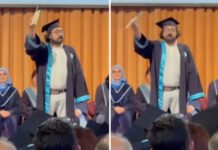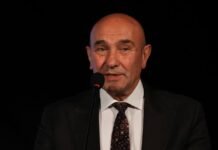A court in the Aegean province of Muğla on Wednesday sentenced 34 suspects to 4 aggravated life sentences in the trial of soldiers charged with allegedly plotting to kill Turkish autocratic President Recep Tayyip Erdoğan during a controversial coup attempt on July 15, 2016.
The court, which heard 47 suspects charged with the same accusations, has also ruled for the separation of the files of US-based Turkish scholar Fethullah Gülen, former captain Burkay Karatepe, and former lieutenant colonel Özcan Karacan, from the case’s main file.
Former Brigadier General Gökhan Şahin Sönmezateş and former Sergeant Zekeriya Kuzu and former Major Şükrü Seymen were among the defendants who received 4 aggravated life sentences. Along with the aggravated life sentences, Sönmezateş was also given three 18-year jail sentences for stealing three policemen’s wallets.
Erdoğan’s former chief military aide Ali Yazıcı was initially given an aggravated life sentence but the court later reduced his sentenced to 18 years in prison. Asked by the head judge if he had any final words to defend himself at the court, Yazıcı said he would say his last words in another case in which he is also standing trial over the attempted takeover of the army headquarters in Ankara.
Meanwhile, the court acquitted former Lieutenant Colonel Hüseyin Yılmaz of all charges.
The case involved 47 suspects, including 43 who were jailed pending trial and 2 suspects who remain at large, all charged with being part of the “assassination team” targeting Erdoğan. The first hearing was on February 20. Suspects have been accused of the attempted assassination, violation of the constitution, and other crimes against the state during the July 15, 2016 coup attempt.
The defendants were accused of attacking the hotel in the resort of Marmaris where Erdoğan was staying and killing two policemen. Erdoğan had left the hotel much before it was stormed.
On Wednesday the Muğla 2nd Heavy Penalty Court asked for the defendants’ final words during the case’s last hearing, which took place at the provincial Chamber of Commerce and Industry hall due to the inadequacy of the courtrooms at the Muğla court.
Some of the suspects said during the hearing that the prosecution process was undertaken too hastily and the evidence had not been adequately collected, while others said the trial did not proceed fairly.
Responding to questions from reporters on early July 2017 about the slow prosecution of suspects in a failed coup, Turkey’s autocratic President Erdoğan said that the courts will convict many in coup trials by the end of the year. Erdoğan had stated that “I think there will be a significant number of convictions by the end of the year,” said Erdoğan.”
Turkish Prime Minister Binali Yıldırım has also said he would hang the suspects of a botched coup attempt in July 2016 in one month, complaining that coup trials were languishing due to the legal system on late September 2017.
Yıldırım responded to the questions of media representatives during a live broadcast on the Habertürk, TRT Haber, NTV, CNN Türk and A Haber television channels and had said he would not wait long to punish the suspects.
“The courts are giving the verdict, but if it was left to me I would hang them all in a month. The legal system is dragging this out. People are becoming annoyed. Trust in the judiciary is decreasing as the decision is prolonged. It should not be. The case has become mature enough, their hopes will fade away by the end of the year. … There are around 50,400 people under arrest and just as many have been released on judicial probation.”
Turkey survived a controversial military coup attempt on July 15, 2016 that killed 249 people. Immediately after the putsch the ruling Justice and Development Party (AKP) government along with President Erdoğan pinned the blame on the Gülen movement.
Fethullah Gülen, who inspired the movement, strongly denied having any role in the failed coup and called for an international investigation into it, but President Erdoğan — calling the coup attempt “a gift from God” — and the government initiated a widespread purge aimed at cleansing sympathizers of the movement from within state institutions, dehumanizing its popular figures and putting them in custody.
Turkey’s Justice Ministry announced on July 13 that 50,510 people have been arrested and 169,013 have been the subject of legal proceedings on coup charges since the failed coup. Turkish government has also suspended or dismissed more than 150,000 judges, teachers, police and civil servants after the coup attempt.
In a report released by Stockholm Centre for Freedom (SCF) on Jul 5, 2017 over the coup attempt, the claims over the alleged assassination attempt targeting Erdoğan was covered as follow:
“Muğla’s Marmaris district was undoubtedly one of the most signifcant locations of the July 15 coup attempt along with Ankara and İstanbul. The events that transpired in Marmaris, where President Erdoğan and his family were on holiday, provide important clues to July 15.
Reviewing the meeting minutes including those from the Parliamentary Investigation Commission, Marmaris Indictment, Akıncı Air Base Indictment and the statements from the tried soldiers helps us understand the events in Marmaris.The events that took place in Marmaris on July 15 can be summarized as follows: President Erdoğan learned about the coup attempt when he and his family were in the region for a holiday.
He made his first announcement to thirteen journalists in front of the residence from which he went live on CNN Türk via FaceTime and called people to the streets. He then travelled to Dalaman Airport by helicopter, and from there he ew to İstanbul on an ATA airplane. Three hours after Erdoğan left, three military helicopters bearing putschist soldiers landed near the hotel where he had been staying. His protection detail, who had remained at the hotel because there was not enough room in the helicopter which had left with the president, and police of cers in Marmaris who were on duty exchanged gun re with the soldiers. When a helicopter that came to evacuate them, because of the resistance from the president’s guard and police, the putschist soldiers failed to get on and spread into a wooded area nearby, from where they were later caught and arrested.
According to the indictment written and submitted to Muğla 2nd High Criminal Court by Chief Prosecutor Necip Topuz, who was appointed ve days after the coup attempt, 47 persons, one of whom was fugitive and 37 soldiers, are being tried for an assassination attempt on the life of the president, infringement of the Constitution, crime against the legislative branch, crime against the government, membership of an armed terrorist organization, premeditated murder during public duty (twice), attempting premeditated murder during public duty (fourteen times), depriving persons of freedom by using force and threat repeatedly, in icting grievous bodily harm, repeated armed threats, vandalizing public property (twice), vandalizing property (nineteen times), and aggravated violation of dwelling immunity. The trial is called “the trial for the assassination of the president” by the Public Prosecutor’s Of ce, and pro-government media.
Serkan Yazıcı, who owned The Grand Yazıcı Hotel and the luxurious villa where Erdoğan stayed with his family, provided information to the Parliamentary Investigation Commission about when President Erdoğan’s visit to Marmaris was arranged. Yazıcı says that he went to Istanbul to meet the president, who had just returned from the Warsaw NATO Summit, so that he could make up for the embarrassment when he could not answer the president’s call on time at the Eid Festival of July 5-7, 2016 and give him his best wishes for the celebration. Serkan Yazıcı reported about the day, whose date he could not remember at rst, that the famous football player Samuel Eto’o of Antalya Sports Club was among the people who met Erdoğan and he invited the president to an exhibition match in Antalya that his foundation was organizing for July 16, in which world famous football players would participate. He says that Erdoğan promised to go. Archives show that day was July 9, 2016, as Yazıcı con rmed later.224 Yazıcı says that he met the president at the airport and invited him to the hotel for a holiday. He adds that he later talked to the president’s Executive Assistant Hasan Doğan about the details and told him that the place where Erdoğan would stay was a private residence separated from the rest of the hotel facility.
Commission about when President Erdoğan’s visit to Marmaris was arranged. Yazıcı says that he went to Istanbul to meet the president, who had just returned from the Warsaw NATO Summit, so that he could make up for the embarrassment when he could not answer the president’s call on time at the Eid Festival of July 5-7, 2016 and give him his best wishes for the celebration. Serkan Yazıcı reported about the day, whose date he could not remember at rst, that the famous football player Samuel Eto’o of Antalya Sports Club was among the people who met Erdoğan and he invited the president to an exhibition match in Antalya that his foundation was organizing for July 16, in which world famous football players would participate. He says that Erdoğan promised to go. Archives show that day was July 9, 2016, as Yazıcı con rmed later. Yazıcı says that he met the president at the airport and invited him to the hotel for a holiday. He adds that he later talked to the president’s Executive Assistant Hasan Doğan about the details and told him that the place where Erdoğan would stay was a private residence separated from the rest of the hotel facility.
Considering that he had said he would play in an exhibition match on July 16, 2016, it seems that Erdoğan may have made a snap decision to go on holiday with his family and travel to Antalya. The following day, after the July 9 meeting, security police working for the presidency went to Marmaris and did routine security checks at the villa where President Erdoğan would stay. President Erdoğan arrived at the hotel in the evening on July 11, 2016 without taking any of his military aides along with him. Serkan Yazıcı reports that
he did not see Erdoğan until July 14. When media websites and newspaper articles are examined, it can be seen that there is no news about where Erdoğan was for the July 11–July 14 period, neither in the pro-Erdoğan nor the dissident media. The news about Erdoğan in the pro-Erdoğan media comes to an abrupt stop. Commission minutes hold that Erdoğan left the villa where he was staying to examine the presidency compound in Okluk Bay on July 14. Erdoğan made the trip in the hotel’s helicopter.
On the night of July 14, an appalling terrorist attack was carried out with a cargo truck in Nice, France. Previously, on November 13, 2015 there had been another attack in Paris for which Erdoğan had stood before the cameras late at night, made a statement, and condemned terrorism. For the Nice attack, however, no video announcement was made to camera; only a message of condemnation was released on the presidency website and Twitter.
July 15, 2016 was a Friday. Erdoğan frequently appears in public for Friday prayers when he goes to various places for a visit. It is an opportunity for party members wishing to see him and lawmakers and local of cials wishing to greet and meet him. When the state-owned Anatolian news agency correspondent got wind that Erdoğan could be in the region, he called Muğla AKP lawmaker Nihat Öztürk, who said, “I have been a provincial chairman for four years. Mr. President has come to the region a lot. I can’t know where he is for security purposes and they would never tell me. There’s no chance you can nd out. He shows up somewhere. Because he came during Eid Festival in 2007, we came face to face in Bördübet after Friday prayer. He came to Akkaya in 2004 and went to Friday prayer there…. Go, look, he’ll show up somewhere,” according to commission minutes.
It can be understood that local media workers were guessing that Erdoğan would show up in a mosque somewhere on Friday, July 15 for the Friday prayer. According to the information CHP İzmir lawmaker Aytun Çıray provided at the commission, preparations were made in the Çamlı Village mosque. It always made news when Erdoğan left his hotel for Friday prayer during his holidays in the region this time
Also reported in the commission statements is the fact that Erdoğan’s son-in-law and Energy Minister Berat Albayrak and Erdoğan’s executive assistant Hasan Doğan went on a boat trip at about 15:00 at hotel owner Serkan Yazıcı’s invitation. Doğan learned during this boat trip that president’s place of residence had appeared on the website of Sözcü daily (posted at 16:25), and they decided to return.
After they all returned to the hotel, the President’s Security Director Muhsin Köse said he had to check the perimeter of the villa and asked hotel owner Serkan Yazıcı to accompany him, and they did it together. When they later sat down for some tea, Yazıcı said Security Director Muhsin Köse received a phone call. Yazıcı remembers Köse saying, “I can’t disturb Mr. President now.” He reports that Köse got a second call but this time he rose in panic and said they had to go to the villa. When they got to the villa, he noticed that there was some unusual activity.
The indictment about the coup attempt states that the phone calls Yazıcı talked about were from MİT Undersecretary Hakan Fidan. Deputy Chief of Staff Yaşar Güler says in his statement that during his meeting with Chief of General Staff Akar in the headquarters “Fidan said, ‘Sir let me inform Mr. President about it.’ He said, ‘Can I talk to Mr. President?’ I didn’t hear the response. Fidan then asked, ‘So, Muhsin, do you have enough weapons and men if there is an assault from the outside?’ He got a response but I don’t know what it was. He asked one more time, ‘Muhsin, do you have enough weapons and men if there is an assault from the outside?’ The response must have been positive because he said, ‘Good luck,’ and hung up the phone.”
It can be inferred that the security director answered Hakan Fidan in the af rmative about having enough ammunition and staff for assaults—including those from land, air and sea—at a time when security measures had been decreased to a minimum so that it would not be known that the president was in the region on holiday with his family. It is quite
strange that Erdoğan’s security director did not bother asking the substance of the threat and responded positively to Intelligence chief Fidan when asked if there were enough measures and resources available in case of attack. These phone calls were made at about 19:00. Yazıcı’s similar statement to the commission that there was unusual activity when they arrived at the villa also indicates that information that had been obtained by Muhsin Köse was also received by the team of Erdoğan in the villa and the security team had been taking precautions.
Witness testimonies also show that Erdoğan and his entourage worked on a plan to leave Marmaris. However, no information has been made public about what exactly happened and what was discussed in the villa between 19:00 and 23:00. Erdoğan has said on many TV programs that he was constantly in contact with the prime minister but he failed to get through to Akar and Fidan. Erdoğan said that his rst contact with Fidan was towards 22:00.232 However, there does not seem to be a
reason why he could not reach Hakan Fidan or Hulusi Akar in the period in which Muhsin Köse ran toward the villa in a panic, according to the of cial chronology of events.
A photograph that shows Erdoğan teaching his grandson to read the Qur’an later went viral on social media. Erdoğan said on news channel 24 that the photograph was taken on the night of the coup attempt.233 Journalists tried to correct him, saying, “Was it daytime?” when he said “that night,” but despite attempts at correction he insisted it was night. It is known that there was a coup attempt underway earlier and the security director was called by Hakan Fidan and asked to take precautions against an attack, so Erdoğan’s photograph with his grandson studying the Qur’an leads to controversies about its date and time. It has been claimed that the photograph was shared to support his statement that he learned about the coup attempt at 21:30 from his brother-in-law.
Hotel owner Serkan Yazıcı says that he went to Erdoğan’s room at about 23:00 on the coup night. He told the commission that before that he was ordered by the president’s team to keep all the cars, boats and helicopters on standby. Erdoğan announced on a live aHaber news program on July 29, 2016 that they had made plans for escape from four different airports—Aydın Çıldır, Muğla Dalaman, Milas-Bodrum, and Izmir Adnan Menderes airports. If this information is accurate, experts believe that to prepare four planes and their crew members to be ready on stand- by around 23:30, when Erdoğan said he knew about the coup attempt would have required hours of advance preparations.
Erdoğan held a five-minute press conference with local media workers in Marmaris at 00:04 and called people to the squares and airports. Yet when he saw that the news was not being broadcasted on national TV channels, he went live on CNN Turk via FaceTime at 00:24 and again called people to take to the streets. According to the commission minutes, the local journalists attributed the delay of the announcement to technical dif culties.After his appearance on CNN Turk, Erdoğan and his family boarded the helicopter waiting at the hotel’s heliport and left for Dalaman Airport. Here an ATA airplane which belonged to the presidency was waiting for him. The airplane had come from Izmir Adnan Menderes Airport and landed in Dalaman airport. At 01:30 Erdoğan and his family were quickly transferred to the airplane from the helicopter, which landed near the airplane. According to the details in the Marmaris indictment, the ATA airplane was disguised as a passenger plane with the code THY-8456 and it left Dalaman Airport at 01:43.
Two separate reports about July 15 reveal contradictions on the ight map of Erdoğan’s plane.237 A report by the main opposition party (CHP) notes that a picture taken by Flightradar at 00.30 on July 16, 2106 showed that a plane with the code TK-8456, which was supposedly disguising the president’s plane ATA-TC, was clearly identi ed as a government plane. In other words, the president’s plane was in descent over the Marmara Sea within minutes of Istanbul Atatürk Airport. The data showed the departure point as Dalaman but did not say the destination point. “The of cial statement was that president arrived in Istanbul at 03.20 on July 16, 2016. But this screen shot showed the plane with a substitute ight code was in descent over Istanbul approximately 2 or 2.5 hours earlier,” the report said. This report also pointed out that the president’s plane took off from Dalaman but did not y directly to Istanbul, instead ew towards İzmir rst, then moved towards Mudanya and circled around there for a while before proceeding to the Marmara Sea fora descent to Istanbul. The report said both president and prime minister have been trying to cover up very many details of what happened on July 15, leaving many unanswered questions. The burning question is why Erdoğan picked Istanbul airport, which was controlled by the military, instead of secure airports like Esenboğa in Ankara or dozens of other airports that had not been taken over by coup plotters. The con icting statements by Erdoğan and his family members muddy the water further, whether the rst destination was Istanbul or not.
According to the commission notes, local of cials and security of cers were very relieved when they saw Erdoğan off safely. Yet while they were engaged in taking other precautions in the province, they received another piece of news from Marmaris. At about 03:20 three military helicopters were hovering near the hotel Erdoğan had left two hours before. When he rst heard this news, of which no one could make sense, Muğla Police Commissioner Hakan Çetinkaya stated that he thought the putschists had come to take Marmaris District Police Center.
Contrary to the police commissioner’s guess, the soldiers had come to take Erdoğan, who was no longer at the hotel, and take him to Akıncı Air Base. The operation was being commanded by Brigadier-General Gökhan Şahin Sönmezateş, who later stated he had received the order from Brigadier-General Semih Terzi, who was killed during the coup attempt. Sönmezateş said that he had spoken to Semih Terzi on a secure military line on Monday and Wednesday before the day of the coup and was ordered to assemble a team. Thinking that it was a military operation within the chain of command, Sönmezateş stated that after his aide brought him the declaration by the general staff he believed the developments were unfolding as expected and the Armed Forces (TSK) had seized the government within the chain of command.
The Marmaris Indictment and commission reports include great detail about where
the helicopters came from, where they fueled up, how they were seized, and where the ammunition was. Yet there is no answer to the most critical question about July 15: Why did the soldiers come to Marmaris two hours after Erdoğan left?
On a night when television was broadcasting live, the Internet was open and unrestricted, and mobile phones were working without a problem, it is very interesting that the soldiers who took part in the operation were so isolated from the world. The soldiers’ statements show that they were in contact with the outside world and could get on the Internet via their mobile phones.
The military experts interviewed on condition of anonymity by Stockholm Center for Freedom explained that units that go on an operation with air vehicles must be in constant contact with a point on land, and it is impossible to think otherwise. According to this routine procedure of the TSK, the contact spot on land should have followed the developments, coordinated moves, and communicated them to the units in the air on a night when all means of communication were open. There is strong evidence that this did not happen or there was some different instruction. The operation commander Brigadier-General Sönmezateş stated that they were kept waiting for four hours at İzmir Çiğli Military Base. De ning this as a “mastermind,” Sönmezateş said, “We got the instructions to wait from Akıncı Air Base Operation Center. I spoke to a Lieutenant-Colonel called Hüseyin whose last name I can’t remember. But I know which generals gave the order. I thought the order was given within the chain of command. I expect those generals to give an explanation.” No information has been made public about the names of the generals or military staff who sent the team to take Erdoğan, kept them waiting, and then directed them to Marmaris hours after Erdoğan left. It is unknown what roles these persons had in the coup or whether they are still on duty. The military experts interviewed by SCF nd it impossible to explain how the putschists tried to take the No. 1 target of the coup in such an amateurish way when one considers the structure of the special forces and the TSK’s operation procedures.
It can be seen that the soldiers had planned to take the president from the Okluk Bay site, which belongs to the presidency. Among the pieces of evidence seized were preparations made on an Okluk Bay map with acetate pens. It is quite interesting that the soldiers did not know where Erdoğan was even after the hotel where Erdoğan was staying was revealed in the afternoon and posted on media websites. Also included in the Marmaris Indictment is the fact that the soldiers who landed the helicopters had to ask people around there for the address of the hotel.
If the arrival of soldiers on the bridge in Istanbul is taken as the beginning of the coup, there is no explanation for the 6-hour delay against the primary target.
The helicopter that took Erdoğan from his hotel landed at Dalaman Airport, which is a joint civilian and military airport.243 The Coup Commission reports hold that there were four military staff in the tower, two of whom were airmen and the other two marines. There are two command centers next to the airport, one of Naval Forces and the other of Air Forces. It was a huge risk for a president who was being threatened by a military coup to go to Istanbul via an airport also used by soldiers. The security detail who arrived at the Dalaman Airport before Erdoğan replied to police of cers who offered to evacuate the military staff from the tower or incapacitate them that it was not necessary.
The Akıncı Air Base Indictment indicates that a black minivan with its beacon light on approached the left wing of the presidential airplane parked at lot no. 5 and checked the airplane between 00:53 and 00:57. Despite this information, which means the president’s plane had been spotted, Erdoğan continued with the departure plan from Dalaman, which Erdoğan said was one of the four planes readied for him. Another unusual detail is the fact that of all the airports in Turkey the putschists only tried to take the airports in Istanbul on July 15. Ankara-Esenboga Airport was not included in any plan, which is remarkable when compared with previous coups. Erdoğan went to land in Istanbul Atatürk Airport, which is next to the Air Force Academy, at a time when planes and helicopters were taking off and was insistent on landing there, which cannot be explained by the tower being cleared of putschists.
In his interview on CNN International immediately after the coup Erdoğan said, “If I’d stayed 15 minutes longer, I’d have been killed,” a claim he repeated several times later. The information in the prosecutor’s indictment, witness testimonies and commission reports clearly show that the soldiers arrived in the area of the hotel more than two hours after Erdoğan had left. The president shared information with the public that con icts with the evidence.
About 15–20 minutes away from the hotel where Erdoğan was staying is Aksaz Marine Base, which is one of the most important military establishments in Turkey. Brigadier- General Namık Alper, the commander of the base, was detained on the morning of July 16 and then arrested. Statements indicate that Erdoğan and his entourage kept this plan in mind when making their exit plan, and Muğla Police Headquarters was anxious to take precautions against Aksaz. The base had two divisions, nearly four thousand staff, warships, and antiaircraft guns, yet it did not make any attempt to move on Erdoğan’s hotel. The military experts Stockholm Center for Freedom has interviewed nd it odd that this base was not included in coup plans when it could have provided active support to land and air forces.
The military team that went to Marmaris stated that they were going to take the president
to Akıncı Air Base on a military airplane that was waiting for them if they could have achieved their target. Yet such an airplane landed neither at Çiğli Air Base nor at another airport nearby. This information con rms that the soldiers in the operation were left in the lurch, yet the prosecutor stated that there was no hard evidence about the soldiers’ return plan and used this lack as support for his assassination argument in the indictment.There are also suspicions about the death of two police of cers killed during the raid on the hotel in Marmaris. The indictment says that one of the of cers was killed with Major Seymen’s gun, while no forensic or ballistic report was obtained about the bullet that killed the other of cer. The soldiers claim that the police of cers killed their colleagues in friendly re.
A British tourist, Martin Brady, who contacted SCF after Turkish version of this report was published earlier, provided his account of what he witnessed that night. The booking documents he shared indicates Brady and his family stayed at Grand Yazıcı Hotel on July 15, 2016. Their room was located next to the one where police bodyguards of Erdoğan were staying. “Gunshots being red constantly. However, we never witnessed the soldier shoot. I’m not sure where the shots where coming from. I believe the rst to shot had to be the security of the president who had be waiting to ambush the suspected coup plotters”, Brady said. He maintained that because of the layout of the hotel it would be impossible for anybody to know exactly where any security personnel where staying. He holeds a rm view that rst shot should have to come from Erdoğan’s security. Brady’s recollection corroborates the account provided by a suspect during the sixth hearing of the Marmaris trial. Gökhan Güçlü, non-commissioned of cer, testi ed in the court that it was a part of the plot that a master mind staged the skirmish between the police of cers and soldiers, hoping for even a massacre with more casualties despite the fact that Erdoğan left the hotel hours before troops arrived.
A Doğan News Agency reporter who went to the hotel for Erdoğan’s press conference reported that there were intelligence agents there in a Transporter that had advanced technological equipment in it.
When Erdoğan appeared live on CNN Turk, someone was heard in the background telling Erdoğan, “Say, I’m the commander-in-chief.” The identity of the person next to the president who could speak so informally with him led to much speculation but no de nitive answers.
According to Parliamentary Investigation Commission minutes, during the deployment of the putschists to Çiğli and their wait there, two pilots refused to support the putschists and disabled their helicopters. One pilot was assigned to take the Aegean Army Commander. All these pilots were purged from the army. It is not known why the pilot who openly resisted the coup by disabling the putschists’ vehicle was purged.”















